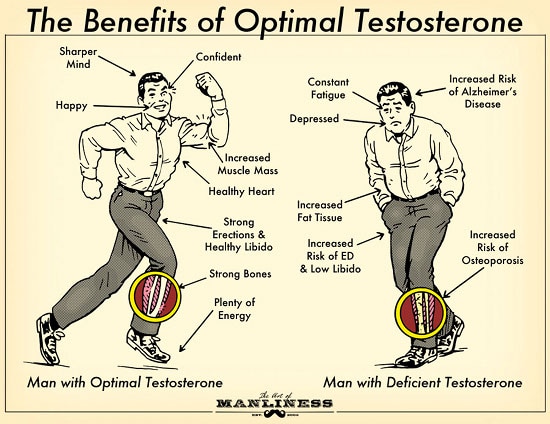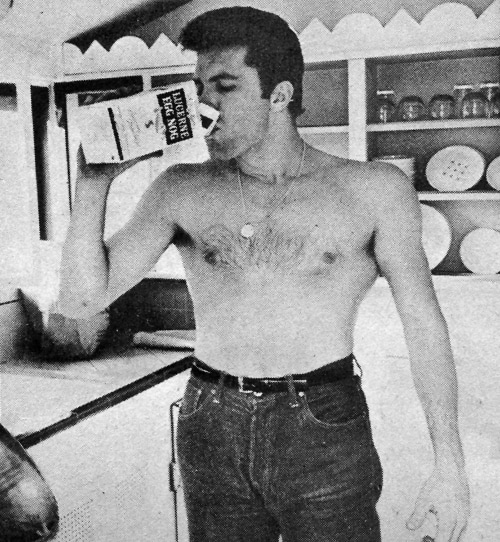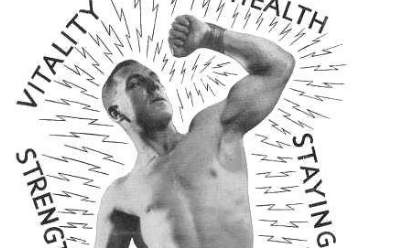Welcome back to Testosterone Week! If you’re just joining us, I recommend checking out our two previous posts in the series: the benefits of testosterone and a short primer on how T is made.
Today we’ll be taking a look at what’s considered a normal testosterone level and how you can get your testosterone levels tested. As I began researching testosterone levels and hormone testing for this series, I quickly learned that there’s a lot of conflicting and confusing information out there — some websites will say that “X” is a normal testosterone level, while another website says “Y” is the ideal range. Even medical labs give conflicting numbers on what’s a normal testosterone level.
Why so much confusion?
The problem is that there hasn’t been much standardization in hormone testing, particularly regarding T levels. Different labs use different methods (and measurements), which has only created confusion among consumers and even family doctors about what testosterone level results even mean. At the same time, as I’ll explain below, what can be a “normal,” healthy level of T for one guy, can be an abnormal, unhealthy level for another.
I hope in this post I can clarify some of the confusion surrounding testosterone levels and hormone tests. I’ll be straight with you. This stuff is super confusing. I’ve done my best to synthesize all the disparate info out there into an easy-to-read format for the layman and have sought to create the most accessible resource on the web. But, I’m not a scientist or doctor, and you may receive more accurate information by consulting a medical professional.
Total and Free Testosterone Levels
Before we begin, I want to reiterate a fact we’ve previously discussed in this series: there are three different types of testosterone floating in your body: free testosterone, SHBG-bound testosterone, and albumin-bound testosterone. When you get tested, there are two tests you can get: total testosterone and free testosterone.
Total testosterone is the total amount of T floating in your blood at the time of the test: free, SHBG-bound, and albumin-bound combined. Total testosterone is typically measured in ng/dl, or nanograms per decilitre.
Free testosterone is the measurement of — you guessed it — free testosterone (which often includes albumin-bound testosterone as well because it can easily convert to free T). Free T is typically measured in picograms per milliliter. As we’ll discuss later in this post, because free testosterone makes up such a tiny, tiny percentage of your total T, it’s really hard to measure accurately. So, when you see research on normal testosterone levels, it usually focuses on total testosterone. Consequently, most of the numbers in this post will be about total T levels. With that said, I do include some references to research that indicates what average and optimal free testosterone levels are.
What’s a “Normal” Testosterone Level?
When you go to get tested for testosterone, the lab will often show you what’s considered the “normal” range among patients who have tested with that particular lab. It’s called the “reference range.”
For example, LabCorp (the lab I used to test my T levels here in Tulsa, OK) shows a reference range of 348 – 1197 ng/dl (nanograms per decilitre) for total testosterone levels. According to this reference range, my total testosterone level of 383 ng/dl at the beginning of my experiment would mean my total T levels were — barely — within the normal range.
However, there are a couple of problems with just using this reference range to figure out if your T levels are “normal.”
The first is that this reference range consists of a wide variety of men who tested with LabCorp: 80-year-old men and 20-year-old men; obese men and super fit men; men with pituitary gland problems and men with glands that work like champs.
The second problem is that the numbers you get back from testosterone tests don’t take into account your individual androgen sensitivity, a subject I discussed with oncologist Chris Ryan on the podcast. Some dudes are more and less sensitive to testosterone than others. Androgen sensitivity is determined by genetics and by factors you experienced in-utero. There’s nothing you can do about increasing your sensitivity to testosterone once you’ve left the womb.
Based on your androgen sensitivity, you may need more or less circulating testosterone in your blood to get the benefits of T and to feel vital and healthy. You might have what’s considered on the low range of testosterone levels for your age, but not have any symptoms of low testosterone. Or you could have have average levels, but are feeling the symptoms of low T.
So sure, my 383 ng/dl was considered normal, but what does that mean? At 383 ng/dl I was feeling pretty crappy. Low energy, not strong, fluffy, low motivation. All the signs of low testosterone. But another guy could have that number and feel great because he’s more sensitive to testosterone than me.
All this is to say that while the ranges for “normal” levels of testosterone put out there by doctors and labs can be useful as a general measuring stick, they’re not the only thing that should be considered when determining if you have low testosterone. You have to also take into account your age, as well as how you feel physically and emotionally. As long as you’re not suffering any symptoms of low testosterone, your testosterone levels are probably fine even if your testosterone level is at the low end of normal.
Average Testosterone Levels by Age
When determining what’s considered a normal testosterone level, it’s best to look at what the reference range is for men your age. Researchers have known for years that T levels typically drop by about 1% every year after you hit your mid-30s. So if you’re 35, comparing yourself to a bunch of 80-year-old men isn’t very useful because they likely have really low T levels.
Unfortunately, many labs don’t break down reference ranges by age. However, studies have been done in which researchers do just that. Below, I include the results from two such studies.
| Measurements in Conventional Units (ng/dl), SHBG in (nmol/L) |
| Age | # Subjects | Total Test. | Stand. Dev. | Free Test. | Stand. Dev. | SHBG | Stand. Dev. |
|---|---|---|---|---|---|---|---|
| 25-34 | 45 | 617 | 170 | 12.3 | 2.8 | 35.5 | 8.8 |
| 35-44 | 22 | 668 | 212 | 10.3 | 1.2 | 40.1 | 7.9 |
| 45-54 | 23 | 606 | 213 | 9.1 | 2.2 | 44.6 | 8.2 |
| 55-64 | 43 | 562 | 195 | 8.3 | 2.1 | 45.5 | 8.8 |
| 65-74 | 47 | 524 | 197 | 6.9 | 2.3 | 48.7 | 14.2 |
| 75-84 | 48 | 471 | 169 | 6.0 | 2.3 | 51.0 | 22.7 |
| 85-100 | 21 | 376 | 134 | 5.4 | 2.3 | 65.9 | 22.8 |
The above chart groups men into seven 10-year age increments. It’s based on results from this 1996 study. According to this chart, my T level at the beginning of the experiment (383 ng/dl) was closer to the average of an 85-100-year-old man. Yikes! This chart also lists the average free testosterone levels of the subjects. My beginning free testosterone was below the average of men my age and my end level was above average.
In a study done that same year by another team of researchers, they produced the following chart of testosterone levels broken down by age:
| Measurements in Conventional Units (ng/dl) |
| Age | Number of Subjects | Mean Total Test | Stand. Dev. | Median Total Test | 5th % | 10th % | 95th % |
|---|---|---|---|---|---|---|---|
| <25 | 125 | 692 | 158 | 697 | 408 | 468 | 956 |
| 25-29 | 354 | 669 | 206 | 637 | 388 | 438 | 1005 |
| 30-34 | 330 | 621 | 194 | 597 | 348 | 388 | 975 |
| 35-39 | 212 | 597 | 189 | 567 | 329 | 388 | 945 |
| 40-44 | 148 | 597 | 198 | 597 | 319 | 378 | 936 |
| 45-49 | 154 | 546 | 163 | 527 | 329 | 358 | 846 |
| 50-54 | 164 | 544 | 187 | 518 | 289 | 348 | 936 |
| 55-59 | 155 | 552 | 174 | 547 | 319 | 338 | 866 |
While this chart doesn’t show average free testosterone levels, I like the fact that it shows the T levels of men in the bottom five and ten percentiles as well as the T levels of the men in the top 95%. You can see how you compare to men with the lowest and highest T levels.
According to this chart, my beginning T level (383 ng/dl) was near the bottom 5% and 10% across all age groups. Even for 55-59-year-old men.
My testosterone level after 90 days of good living (778 ng/dl), was above average for my age group.
As far as normal percentages of free testosterone go, ~2-3% is considered normal. If you’re significantly below that percentage range, you’ll likely experience symptoms of low T even if your total T is average or above average.
Go for Optimal
If your testosterone levels match up with the average in the charts above, it’s safe to say that you have adequate amounts of T in your system.
Though again, the number you get from a testosterone test shouldn’t be the only thing you look at when determining whether you have low testosterone, and you should also check in with how you feel.
Every man is different, so their level of optimal testosterone will be different, too. For some men, a testosterone level of 600 ng/dl will make them feel great, while other men need to be around 400 ng/dl in order to experience the benefits of T.
Clinical research still hasn’t determined a hard threshold level for when symptoms of low T begin appearing. Some recent research suggests that symptoms of low T might begin appearing in men when their total testosterone level dips below 320 ng/dl.
So that’s a good rule of thumb for the lower threshold. If you’re above 320 ng/dl you’re probably fine. Not great. But fine. And from there you can shoot for levels that are in the higher range for your age group.
But it’s important to note that optimal testosterone doesn’t necessarily mean you need super-high levels. Past a certain level, testosterone can actually cause a bunch of not-so-good side effects, like sleep apnea and overly thick blood. You typically only have to worry about too much testosterone if you’re using testosterone replacement therapy. Barring some physiological defect, too much T usually isn’t a problem found in men increasing their testosterone naturally through changes in lifestyle and diet.
How to Measure Your Testosterone Level
There are three ways to test your testosterone levels: saliva sample, urine sample, and blood sample. Each method has its pros and cons.
Saliva and urine tests are relatively inexpensive and fast. You can even buy a saliva test kit on Amazon for about $30. Just spit in the cup, put it in the mail, and a week later you’ll get a total testosterone measurement. The problem is that saliva and urine tests aren’t very accurate, which is why endocrinologists typically don’t use saliva or urine samples when diagnosing low testosterone levels. Instead they use blood serum tests.
While blood tests are much more accurate and sensitive than saliva or urine tests, they’re also much more expensive — blood tests for total and free testosterone can set you back $130. Because I wanted the most accurate results, I went with the blood serum testing.
What I didn’t know before I got tested was that there are different kinds of testosterone blood tests, some more accurate than others. As I mentioned at the beginning of the post, there isn’t much standardization amongst labs when it comes to testing. Some labs use one method, while another lab will use another test.
I later learned that the blood test I used to measure my total testosterone for my experiment wasn’t the most accurate on the market and wasn’t what the CDC is recommending labs use in their goal to standardize hormone testing. (I tested myself a month after my 90-day experiment with the blood test the CDC recommends. I’ll share my results in a bit.) I also learned that measuring free testosterone is pretty dang hard and that most free T measurements that labs give are typically just estimates.
Below I share what I learned about the confusing world of testosterone blood tests.
Blood Tests for Total Testosterone
ECLIA Method. When I tested myself for total testosterone for my experiment, the method the lab used was ECLIA, short for Electrochemiluminescent Immunoassay. It’s a fast and affordable method to measure total testosterone in your blood. Many labs use this method because it’s automatic and doesn’t require too much work on a lab technician’s part. However, some studies have shown that values obtained with ECLIA are significantly higher compared to the more reliable LC/MS method. Which brings me to…
LC/MS Method. LC/MS is short for liquid chromatography-mass spectrometry. It’s considered the gold standard method by many researchers in measuring small molecules. Its accuracy and consistency is why the CDC is recommending LC/MS to be the standard method used when testing total testosterone. Because LC/MS is more sensitive than ECLIA, doctors typically use this method when testing patients with really low testosterone levels, such as women and children. While it’s more accurate and sensitive, the LC/MS method is more expensive than ECLIA. And it takes a bit longer to get your results.
A month after my 90-day experiment, I got tested again, but this time using the LC/MS method. My total testosterone level using this method was 826.9 ng/dl. Meaning my T levels increased even more since starting my testosterone changes.
You’ll have to make the call on which method you go with. If you don’t think you have extremely low T, ECLIA will work just fine. Just know that most researchers see LC/MS as the method that produces the most accurate and consistent results. Labs often offer both ECLIA and LC/MS tests. Later on, I’ll share where you can get tested using either method.
Blood Tests for Measuring Free Testosterone
Reading about the myriad ways to measure free testosterone has nearly put me in the nut house. It’s confusing.
The problem that labs face is that there is so little free testosterone in our body, it’s hard to measure directly. Below I lay out the methods available right now to measure free T.
RIA Direct. It’s cheap, fast, but not very accurate. Recent studies have been calling into question the use of RIA direct methodology to measure free testosterone. Unfortunately, most labs across the country only use RIA direct because of its cost effectiveness. LabCorp, the lab I used, only measures free T using RIA direct. Despite the criticisms levied at RIA direct tests, many researchers believe it’s an adequate method for routine tests.
Equilibrium Ultrafiltration. Many in the field of endocrinology argue that equilibrium ultrafiltration is a superior and more accurate testing method to RIA direct. The problem is that many commercial labs don’t offer the method because it’s so time consuming and requires well-trained technicians. If you can find a lab that uses equilibrium ultrafiltration, expect to spend a bit more than you would for a RIA direct.
Calculated free testosterone. Instead of directly measuring free testosterone in your blood, it’s possible to get a rough estimate by calculating the amount of albumin, SHBG, and total testosterone in your blood. The problem with this method is that 1) it’s not very accurate and 2) it requires you to pay for three different tests: albumin, SHBG, and total testosterone. This can get pretty expensive, pretty fast.
As you can see, you have a variety of options when getting tested for T levels. My recommendation is to try to get your total testosterone number using the LC/MS method and use whatever method is available and cost effective to measure free testosterone. Of course, I’m just a guy who writes a blog about manliness, so take that recommendation with a grain of salt.
Where to Get Tested for Testosterone
Alright, so you might be asking your computer screen, “Where do I get tested?”
If you’re suffering symptoms of low testosterone, ask your doctor to order a blood test for you. Insurance might cover it.
If you’re just curious about your T levels, you actually don’t need a doctor’s order. You can sign up for a test yourself.
Here’s how:
Order the test. You’ll need to order a blood test using a website that sells blood tests to consumers. No, you don’t send the website a blood sample. These sites contract with labs across the country to draw blood. They basically act as a middleman. Here are the sites I used to buy my tests:
- Health Testing Centers. You can order a total and free testosterone test for $129. Just be aware the methods that Health Testing Center will request are ECLIA for total testosterone and RIA direct for free testosterone.
- Request a Test. You can order a LC/MS total testosterone test from Request a Test. They say you can order an equilibrium ultrafiltration free testosterone test, but when I got my lab results back, it showed that the direct method was used. I’m still looking into that, but wanted to give you the heads up.
You can also order albumin and SHBG tests from both Health Testing Centers and Request a Test so you can use the calculation method to figure out your free testosterone levels.
Go to a local lab. After you pay for your blood test, you’ll get an email from the website with your order information. You’ll also be told which lab you need to visit in your area to have the test done. Both Health Testing Centers and Request a Test sent me to LabCorp. If you’ve ever applied for a job that requires a drug test, you’ve probably been to LabCorp yourself, as they are a national company.
Get blood drawn. A lab technician will draw some blood samples. The whole process takes less than 2 minutes. It’s best to get your blood drawn first thing in the morning, as T levels are at their highest in the morning and steadily decline throughout the day.
Get your results. Two or three days later, you’ll get an email from the lab with your results.
Test more than once. Because testosterone levels are sensitive to a whole host of environmental factors, it’s important to get tested more than once when diagnosing low T. You could have below average T levels one week, but slightly above average the next. This is particularly important if your doctor is considering putting you on testosterone replacement therapy. You don’t want him to make the decision from a single test!
Conclusion
Whoo, that was a lot of info. If you feel a little lost, here’s a crib sheet:
- To find your free T, try to use the Equilibrium Ultrafiltration test — it’s the most accurate. If that method isn’t available, the RIA Direct test will work okay.
- Take a blood test to determine your total T levels. You can get this blood test at the doctor, or by signing up online and going to a local lab. Make sure to get tested in the morning!
- If you can, take the LC/MS test to measure your total T — it’s the most accurate. If that’s not available, the ECLIA test will work okay.
- Don’t use lab reference numbers to determine if your T is low. They’re not usually accurate. Use the charts above for your specific age range.
- Even if your T is low for your age range, if you feel healthy, your T levels may be okay; you may simply be more androgen sensitive.
If you’re confused about how you know if you need to address and increase your testosterone levels or not, the simple bottom line is this:
- Everyone, regardless of their current T level, can benefit from the healthy lifestyle practices that boost testosterone (which I’ll detail tomorrow). Even if you’re not focused on boosting your T, they should be adopted anyway for all-around health, and an increase in T will be just another happy byproduct of said adoption.
- The T-boosting practices I’ll recommend can increase anyone’s testosterone from where it currently stands, but even these increased levels may not put you in the high range for your age group.
- If you adopt these T-boosting practices, and your T is still low for your age, but you feel healthy, strong, and vital, then you likely don’t have a problem.
- If you adopt these T-boosting practices, and your T is still low for your age, and you’re still suffering the symptoms of low testosterone, you may have an underlying problem that will need to be addressed by your doctor.
To the specifics of the testosterone-increasing practices I recommend is where we will turn next time in the conclusion to this series.
Testosterone Week Series:
The Declining Virility of Men and the Importance of T
The Benefits of Optimal Testosterone
A Short Primer on How T is Made
What’s a “Normal” Testosterone Level and How to Measure Your T
How I Doubled My Testosterone Levels Naturally and You Can Too








